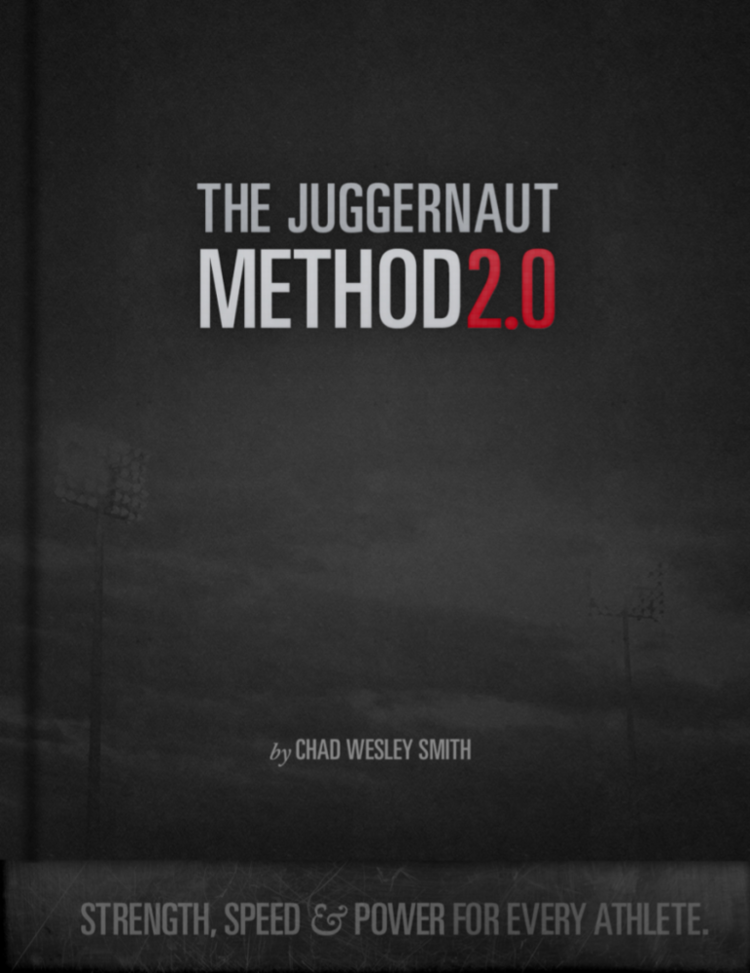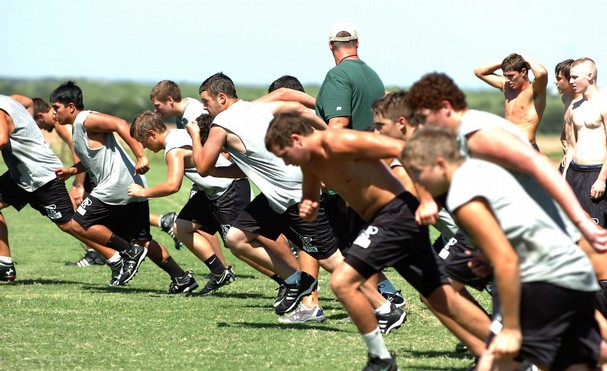Written by Chad Wesley Smith
This past Saturday, I spent the day watching my oldest niece’s soccer team, The Cherry Bombs, in action. After an hour of watching a dozen or so 7 year olds, I became increasingly aware of the fact that the American athletic development system, or lack there of, is broken.
The long-term development of the athlete is a broad issue, but there are three primary factors to focus on to ensure you maximize your young athlete’s long term potential…
-
Focusing on development of athletic traits in the absence of competition.
-
Developing a wide range of motor patterns and physical attributes.
-
Maximizing explosiveness and neural wiring.
Develop Athletic Traits in the Absence of Competition
As I watched the Cherry Bombs bumble around the field Saturday, the idea that young athletes need to be removed from competitive situations was further galvanized in me. Competition, and with it the fear of losing (which is usually much more of an issue for parents than kids), creates an environment that isn’t conducive to technical development. What is the point of trying to be the best soccer player (or any other sport), when the components of the sport (sprinting, passing, etc) can not be properly executed? Placing an emphasis on winning at this point causes coaches to focus on developing strategy and pursuing short term success at the expense of long term skill acquisition, setting a lower ceiling on athlete’s ultimate potential.
Zygmunt Smalcerz, head weightlifting coach at the Olympic Training Center, told us about a clever system that his home country of Poland employs to develop young lifters’ technique. Polish lifters are allowed into traditional competition at the age of 14, but up until that point the lifters compete with standardized weights (50% of bodyweight in the snatch and 75% in the clean & jerk) and the winner is determined by how proficiently the technique is executed, with scoring working similarly to gymnastics or diving.
Now of course, the idea of Americans abandoning formal competition for kids is probably unrealistic, but if you work with young athletes or you are the parent of one, I implore you to put competitive success on the back burner and focus on physical and technical development which, while such a focus may limit the number of wins you achieve in the pee wee division, will significantly impact competitive success as the athlete matures, when success it actually matters.
Develop a Wide Range of Motor Patterns and Physical Attributes
One of the most significant issues facing the development of young athletes is early specialization, which robs them of general motor pattern development-limiting athletic potential and potentially leading to burnout.
The fundamental attributes which constitute athleticism are…
-Mobility
-Balance
-Coordination
-Kinesthetic Sense
-Rhythm
-Relaxation
-Timing
Developing this broad sense of athleticism requires athletes to train in a variety of manners and for the young athlete (early school years), this will be best achieved through a combination of swimming, gymnastics, and track and field, while also recreationally playing various ball sports and typical playground games.
Swimming is foundational because it can be begun before walking and develops all of the above qualities due to the uniqueness of being able to smoothly and efficiently move through water.
Gymnastics is unparalleled in its ability to develop athleticism and can be introduced shortly after a child gains the ability to walk. Gymnastics will create the greatest foundation for athlete’s to build future skills on, regardless of their ultimate sport of choice.
Track and Field is the final piece to the trifecta of youth athletic success. Sprinting, jumping and throwing are foundations of athletic movement and that’s what you do in track. So how can you go wrong? Personally, I know that starting track at age 8, as both a sprinter and shot putter, laid a foundation of success for me and helped me be a much more efficient sprinter than my offensive/defensive linemen counterparts in football.
Olympic Gold Medal Weightlifter Ilya Ilyin described the beginning of his weightlifting training at age 6 years old as “running around the gym and doing all the exercises.” What this exactly means is up for debate, but I would venture to say that it meant he did a combination of weightlifting drills, gymnastics, swimming, track and field drills, bodyweight exercises and played games. This very general training background laid the foundation for one of the most powerful and coordinated athletes of all time.
These three sports, along with other random play in ball sports and playground games, will build general movement qualities and coordination that will allow them to more quickly acquire athletic skills in whatever endeavor they choose. Early specialization may yield short term results and help your child become the best 11 year old baseball player in the county, but by only developing movement patterns specific to one sport you are ultimately capping their potential by limiting their coordination, kinesthetic sense and other athletic qualities.
Maximizing Explosiveness and Neural Wiring
The final step in setting up a young athlete for long-term athletic success is to ensure that you are maximizing their ability to develop maximal force and power, getting the most out of their nervous system and fast twitch fibers.
This is best achieved through avoiding extended duration, high-intensity work and focusing on high quality, high speed movement.
Long duration (>8 sec) high intensity efforts or incomplete recoveries between high intensity efforts (ie. Gassers, suicides, 300yd shuttles) will put the athlete into a highly lactic state, causing a set of highly specific adaptations that aren’t highly beneficial for most sports. Rather than training the athlete to maximize force output at 100% intensity, it trains the athlete to be able to maintain relatively high intensity for long periods of time. This may be beneficial for an aspiring middle distance runner, but most sports simply don’t rely heavily on this energy system.
If you watch elite athletes in almost any sport, you see short all-out bursts, interspersed with longer periods of light jogging or standing around. The two extremes – very powerful bursts, and a general aerobic base – are much more important than the middle ground of training lactate clearance. Don’t waste time that could be spent reinforcing maximal power development, by bastardizing it to instead train an energy system that’s not terribly important for most sports.
Something to consider from the great Charlie Francis, is that when using track and field drills for the youth athlete is that what may be considered pure speed work for the adult (the 100m) would actually be more of a speed-endurance effort for the young athlete. The young athlete who excels in the 100m, is likely to grow up to be the best 400/800m runner, so when looking to develop speed in youth athletes focus on distances <30m.
Learning to move efficiently is the main target of training for the young athlete and this needs to be done in completely rested states at submaximal intensities. This will ensure that proper mechanics are achieved, setting the athlete up to intensify the correct movement patterns over time. Your athletes have years to add velocity and resistance to movements, the early stage of their training careers is the time to ensure proper mechanics are learned.
The proper training of youth athletes can set them up for a lifetime of success, while improper training in the formative years can cap their ultimate athletic potential. This article is just a brief introduction to some of the foundational concepts of setting athletes up for long term success.
I want to say a special thank you as well to James Smith whose training ideas and mentorship helped form much of my thinking about these topics. Thanks James.
If you’re interested in learning more about overall athletic development, pick up a copy of the Juggernaut Method 2.0. If you’re frustrated with the results you’ve been getting and want to know what it REALLY takes to build yourself into the strongest, most explosive, most conditioned athlete possible, the Juggernaut Method 2.0 is THE go-to resource.
Related Articles
What I Did and Should Have Done as a Young Athlete by Chad Smith
The Pyramid of Strength by Chad Smith
Movements to Master for Youth Athletes by Ryan Brown
Youth Athletics and Special Strength by Martin Bingisser
Chad Wesley Smith is the founder and head physical preparation coach at Juggernaut Training Systems. Chad has a diverse athletic background, winning two national championships in the shot put, setting the American Records in powerlifting, including a 900+ raw w/ wraps squat and a 2200+ total, and winning the 2012 North American Strongman championship, where he earned his pro card. In addition to his athletic exploits, Chad has helped over 50 athletes earn Division 1 athletic scholarships since 2009 and worked with many NFL Players and Olympians. Chad is the author of The Juggernaut Method and The Juggernaut Method 2.0 and The Juggernaut Football Manual. Facebook, YouTube, Twitter






